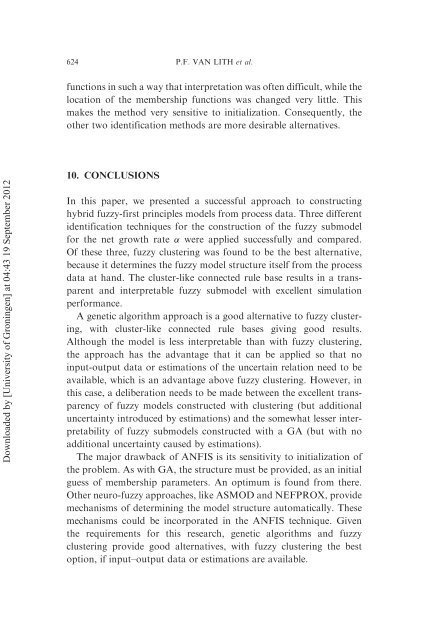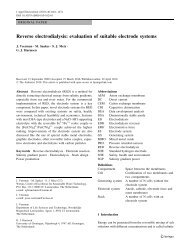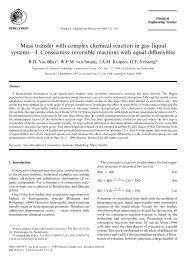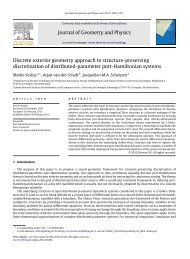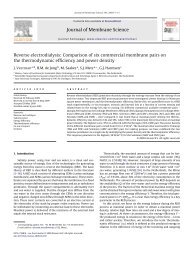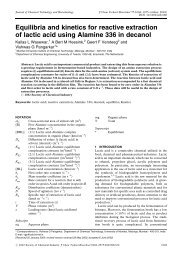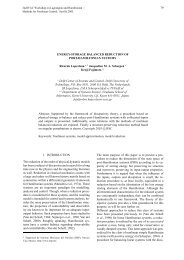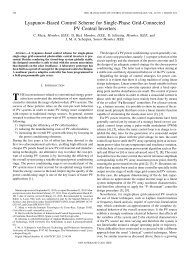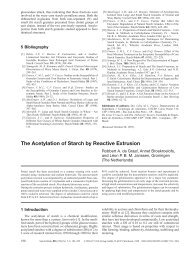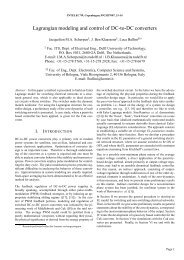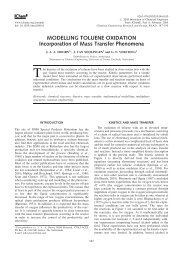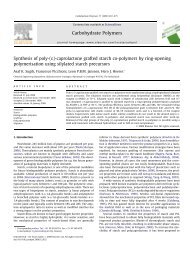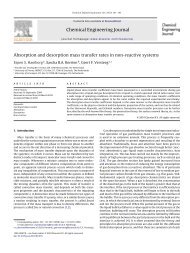FUZZY CLUSTERING, GENETIC ALGORITHMS AND NEURO ... - ITM
FUZZY CLUSTERING, GENETIC ALGORITHMS AND NEURO ... - ITM
FUZZY CLUSTERING, GENETIC ALGORITHMS AND NEURO ... - ITM
You also want an ePaper? Increase the reach of your titles
YUMPU automatically turns print PDFs into web optimized ePapers that Google loves.
624 P.F. VAN LITH et al.<br />
functions in such a way that interpretation was often difficult, while the<br />
location of the membership functions was changed very little. This<br />
makes the method very sensitive to initialization. Consequently, the<br />
other two identification methods are more desirable alternatives.<br />
Downloaded by [University of Groningen] at 04:43 19 September 2012<br />
10. CONCLUSIONS<br />
In this paper, we presented a successful approach to constructing<br />
hybrid fuzzy-first principles models from process data. Three different<br />
identification techniques for the construction of the fuzzy submodel<br />
for the net growth rate were applied successfully and compared.<br />
Of these three, fuzzy clustering was found to be the best alternative,<br />
because it determines the fuzzy model structure itself from the process<br />
data at hand. The cluster-like connected rule base results in a transparent<br />
and interpretable fuzzy submodel with excellent simulation<br />
performance.<br />
A genetic algorithm approach is a good alternative to fuzzy clustering,<br />
with cluster-like connected rule bases giving good results.<br />
Although the model is less interpretable than with fuzzy clustering,<br />
the approach has the advantage that it can be applied so that no<br />
input-output data or estimations of the uncertain relation need to be<br />
available, which is an advantage above fuzzy clustering. However, in<br />
this case, a deliberation needs to be made between the excellent transparency<br />
of fuzzy models constructed with clustering (but additional<br />
uncertainty introduced by estimations) and the somewhat lesser interpretability<br />
of fuzzy submodels constructed with a GA (but with no<br />
additional uncertainty caused by estimations).<br />
The major drawback of ANFIS is its sensitivity to initialization of<br />
the problem. As with GA, the structure must be provided, as an initial<br />
guess of membership parameters. An optimum is found from there.<br />
Other neuro-fuzzy approaches, like ASMOD and NEFPROX, provide<br />
mechanisms of determining the model structure automatically. These<br />
mechanisms could be incorporated in the ANFIS technique. Given<br />
the requirements for this research, genetic algorithms and fuzzy<br />
clustering provide good alternatives, with fuzzy clustering the best<br />
option, if input–output data or estimations are available.


